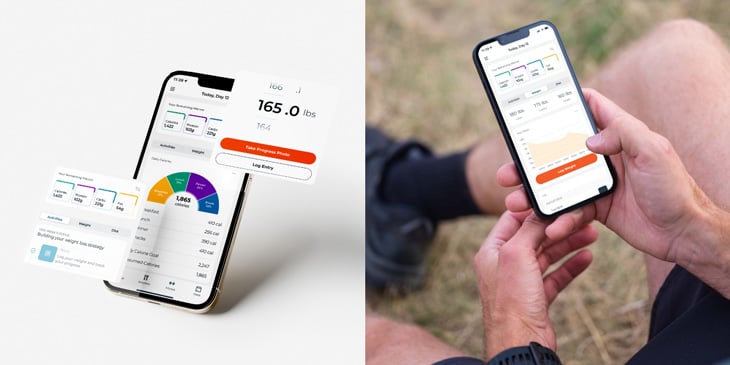You keep hearing that you should be avoiding sugar to improve your health and lose weight, but exactly how much sugar is too much? And does it matter what type of sugar you eat? Here is your full breakdown on what counts as sugar, and the recommended daily sugar intake based on your gender, health, and fitness goals.
How Much Sugar Can You Eat?
The World Health Organization suggests that adults should not eat more than 50 grams of sugar per day, and no more than 5% of their daily calories from added sugars. The American Heart Association recommends limiting added sugar intake below 9 teaspoons (36 grams) for men, and less than 6 teaspoons (25 grams) for women. And according to The Dietary Guidelines for Americans (2020–2025) added sugar intake should be less than 10% of daily calories; for a 2,000 calorie diet that would equal 200 calories or 12 teaspoons.
However, using these guidelines and a combination of fitness and health factors, you can get a pretty good estimate of how many grams of sugar to shoot for.
Like most things, the exact amount of sugar you should be eating each day can differ from one person to the next and depend on individual factors. For some, like athletes, eating more sugar around their workouts can provide performance and muscle gain benefits. Whereas those who live a sedentary lifestyle or those with type 2 diabetes could benefit from a decrease in sugar intake.
This is why even the experts have trouble agreeing on exactly how many grams of sugar per day we should be consuming as a general recommendation.
How many grams of sugar should women eat?
Women who are sedentary or who are concerned about heart health should aim to keep their added sugar intake within the AHA guidelines - below 25 grams per day. This is equivalent to roughly one 8-ounce soda per day or fewer than 2 dessert options per week.
For more active women, increased carbohydrate intake from nutritious whole food sources can help support fitness goals. However, limiting sugar intake to less than 50 grams per day or 10% of calories is still recommended for health reasons.
How many grams of sugar should men eat?
Men who live a sedentary lifestyle or who are at higher risk for developing heart disease should aim to keep their added sugar intake within the AHA guidelines - below 36 grams per day. This is equivalent to roughly less than one 12-ounce soda a day or 3 dessert options per week.
For those who are more active, choosing more carbohydrate-rich foods can support performance and muscle-building goals, but limiting added sugar intake to less than 50 grams per day or 10% of calories is still recommended for health reasons.
How many grams of sugar should diabetics eat?
The amount of sugar recommended for a diabetic should be determined with the help of a dietitian and primary health care provider. Diabetics need to consider total carbohydrate intake along with nutrient pairing and timing to support their individual health goals best, and a well built out nutrition plan can help them achieve this.
Because diabetics are at increased risk for heart health complications, the AHA guidelines for both men and women would ideally be recommended when it comes to added sugar intake - less than 25 grams a day for women and fewer than 36 grams a day for men.
How much sugar should I eat to lose weight?
Low-sugar diets have become a popular approach to weight loss because of their positive impacts on appetite and energy levels. Additionally, following a macro-based diet approach is thought to support improved body composition. However, weight loss is more strongly impacted by daily calorie intake than added sugar intake.
To gain the possible health benefits, aim to keep added sugar intake below 10% of your daily calories or less than 50 grams of added sugar per day.
How to Track Your Daily Sugar Intake
Added sugar is not readily available on the nutrition label for all foods. It takes a bit of research and nutrition know-how to get familiar with spotting high-sugar foods and balancing your intake to your needs. Reading the nutrition and ingredients label is a great starting place.
Additionally, many popular nutrition tracking apps will help you get a good handle on your total carbohydrate intake, and some will break it down into added sugar intake as well. Nutrition tracking is a great way to get more insight into where your intake currently is and what foods are contributing sugar to your diet, making it easier to start cutting out excess sugar!
Stay on top of your nutrition with Trifecta’s free nutrition tracking app! Get professional recommendations for daily macro and calorie needs to help you achieve your goals faster.
What Counts As Sugar?
Sugar is a fairly generic term that can incorporate a wide variety of simple carbohydrates, but not all sugars are considered equal. Foods like fruit, whole grains, and many other nutritious plant-based foods can be a source of natural sugar. These naturally occurring sugars include fructose and lactose, they are simple sugars that provide energy to the body and tend to be found in many nutritious foods.
Naturally occurring sugar is slightly different from sugar that is added to food in the form of table sugar or as an added ingredient in processed foods like ice cream, cereal, and soda. The main difference is when it is consumed in a whole food that provides other nutrients that can help stabilize blood sugar spikes - such as fiber. Whereas added sugar and sweeteners is merely extra sugar added to a food with the intention of increasing sweetness and flavor appeal.
There are over 50 different names for added sugar that can be found in the ingredients list of packaged foods, including sucrose, dextrose, maltose, and high fructose corn syrup. Added sugar also includes many popular natural sugars like coconut sugar, honey, agave, maple syrup, etc.
There has been a lot of debate around the different types of sugars and which type is truly “bad” for your health. But when looking at sugar alone, all types of sugar, regardless of how natural it is, seem to provide the same amount of calories per gram, and have nearly the same effect on blood sugar spikes, weight gain, and other health metrics (1,2,3). This is why food choices, your total intake, and lifestyle has to also be considered.
Why Should You Limit Added Sugar Intake?
We can safely assume that one of the biggest reasons major health organizations advocate for a limit on added sugar intake is that most people are consuming too many carbohydrates and sugar as a whole - putting their nutrition out of balance. Simple sugar is easy to come by, and a majority of people don’t need any extra sugar added to their food. Focusing on added sweeteners and processed foods is a simple way to help people cut back.
Telling people to avoid natural sugars, in addition, may cause them to avoid foods like fruits and dairy, which may provide valuable nutrition.
Because sugar is a component or ingredient in food and not typically considered a food itself, the research surrounding it is tricky. Most of what we can say about the negative impacts of sugar are based on association studies. High amounts of added sugar in the diet have been linked to higher blood pressure, weight gain, diabetes, heart disease, and fatty liver disease, to name a few things (4,5,6).
Additionally, sugar is addictive and can mess with your energy levels, appetite, and mood - all of which can negatively impact your health goals (7,8,9). It is much harder to stick to a healthy lifestyle plan when you experience an energy crash each afternoon, feeling depressed, feeling hungrier than normal, or craving sweets.
Regardless, we understand well enough that too much of anything can be detrimental to one’s health and focusing on a balanced diet that suits your individual needs is always the best approach.


